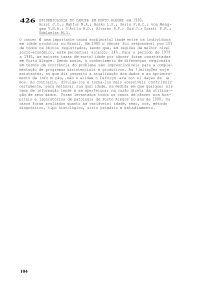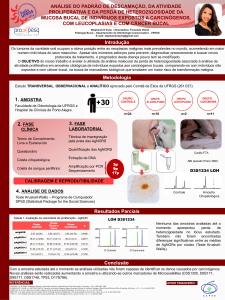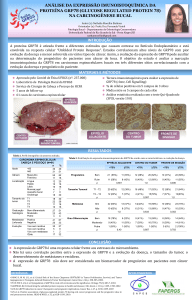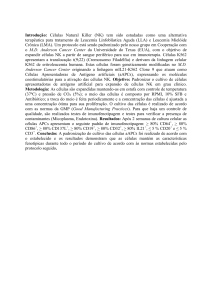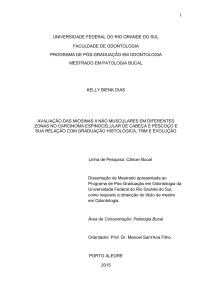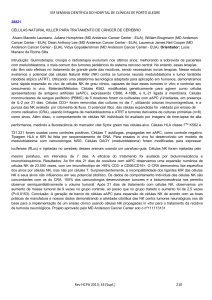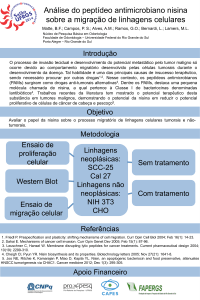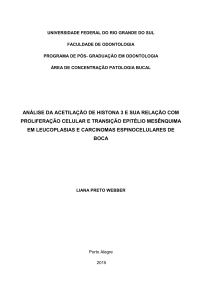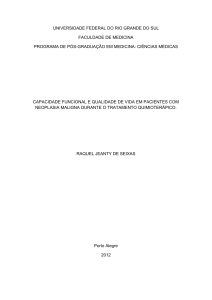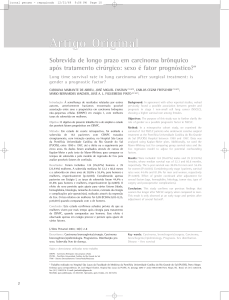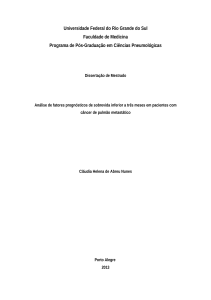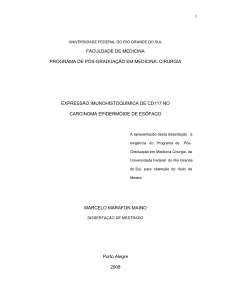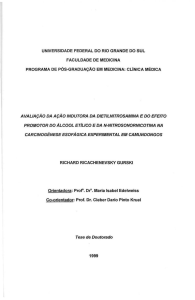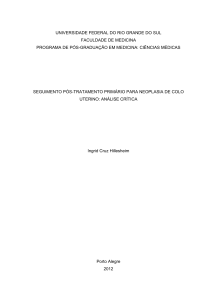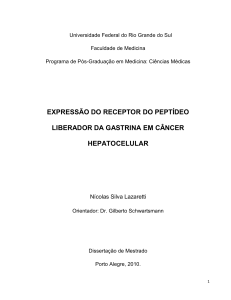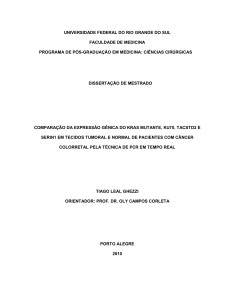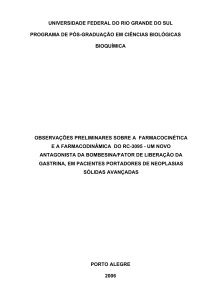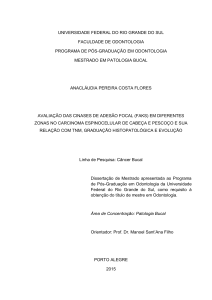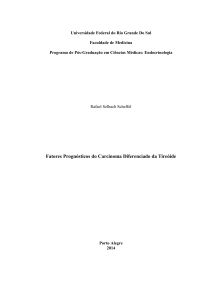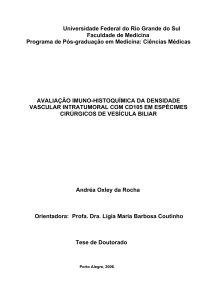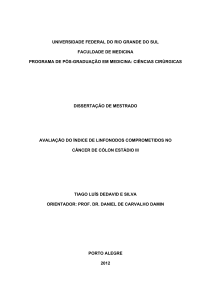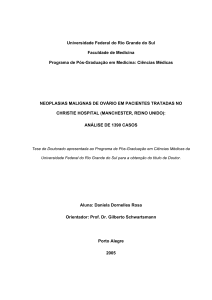UNIVERSIDADE FEDERAL DO RIO GRANDE DO SUL FACULDADE DE ODONTOLOGIA
publicité
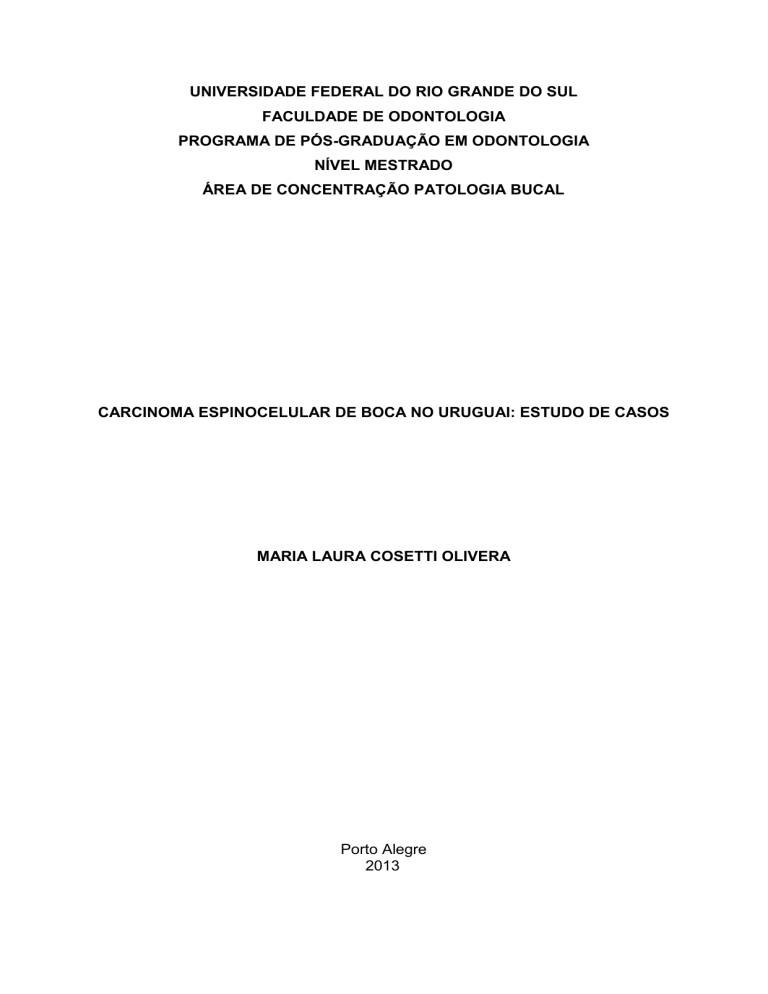
UNIVERSIDADE FEDERAL DO RIO GRANDE DO SUL FACULDADE DE ODONTOLOGIA PROGRAMA DE PÓS-GRADUAÇÃO EM ODONTOLOGIA NÍVEL MESTRADO ÁREA DE CONCENTRAÇÃO PATOLOGIA BUCAL CARCINOMA ESPINOCELULAR DE BOCA NO URUGUAI: ESTUDO DE CASOS MARIA LAURA COSETTI OLIVERA Porto Alegre 2013 UNIVERSIDADE FEDERAL DO RIO GRANDE DO SUL FACULDADE DE ODONTOLOGIA PROGRAMA DE PÓS-GRADUAÇÃO EM ODONTOLOGIA NÍVEL MESTRADO ÁREA DE CONCENTRAÇÃO PATOLOGIA BUCAL Linha de pesquisa: Câncer Bucal Dissertação: CARCINOMA ESPINOCELULAR DE BOCA NO URUGUAI: ESTUDO DE CASOS por MARIA LAURA COSETTI OLIVERA Orientadora: Profa. Dra. Manoela Domingues Martins Porto Alegre 2013 2 MARIA LAURA COSETTI OLIVERA CARCINOMA ESPINOCELULAR DE BOCA NO URUGUAI: ESTUDO DE CASOS Dissertação apresentada ao programa de Pós-Graduação em Odontologia, nível Mestrado, da Universidade Federal do Rio Grande do Sul, como prérequesito final para a obtenção do título de Mestre em Odontologia – Área de concentração em Patologia Bucal. Orientadora: Profa. Dra. Manoela Domingues Martins Porto Alegre 2013 3 DEDICATÓRIA A toda a minha família que, de uma forma ou de outra, permanentemente apoio-me nesta aventura. A meu mentora, Professora Myriam Perez Caffarena, que levo-me pelo caminho vasto e recompensador da Estomatología, ensinou-me a “arte de ensinar” e foi, tantas vezes, minha companheira de rota, muito obrigado pelo seu apoio contínuo, estímulo e compreensão. 4 AGRADECIMENTOS À minha orientadora, Professora Manoela Domingues Martins pelo seu tempo e dedicação, apesar da distância. À o Professor Julio Carzoglio pelo tempo generoso e paciência dedicada a ensinarme a Patologia Oral. À Professora Susana Vazquez Celhay por aderir e colaborar todo o tempo com meu trabalho. Para todos os meus colegas do Departamento de Patologia e Semiologia Oral e Maxilofacial, FOUDELAR, pela sua compreensão quando foi necessário interromper algumas das minhas tarefas. À todos meus companheiros de Pós-Graduação, com quem tive o prazer de compartilhar muitas instâncias deste mestre. À UFRGS e Facultade de Odontología de UDELAR por tornarem possível a realização de meus cursos de Pós-Graduação. 5 SUMÁRIO RESUMO 7 ABSTRACT 9 LISTA DE TABELAS 10 1. INTRODUÇÃO 11 2. OBJETIVOS 19 2.1. Objetivo Geral 19 2.2. Objetivos Específicos 19 ARTIGO CIENTÍFICO 20 Abstract 21 Introduction 22 Matherial and Methodos 23 Results 24 Discussion 31 References 35 3. CONSIDERAÇÔES FINAIS 39 REFERÊNCIAS BIBLIOGRÁFICAS 40 ANEXOS 6 RESUMO Aproximadamente 3% das neoplasias malignas são originadas da cavidade bucal e representadas na maioria pelo carcinoma espinocelular (CEC). Estudos tem demostrado variações nas características clínico-epidemiológicas do CEC de boca de acordo com área geográfica da população estudada. A compreensão das características de uma população específica é importante por muitas razões, incluindo a compreensão da extensão do problema, fatores relacionados com seu desenvolvimento, seu diagnóstico e prognóstico. No entanto, poucos estudos têm sido relatados sobre essa lesão na população Uruguaia. O objetivo deste estudo foi avaliar o perfil demográfico, os aspectos clínicos e terapêuticos, assim como, os fatores prognósticos dos carcinomas espinocelulares de boca (CECB) diagnosticados em serviços públicos no Uruguai. Foram selecionados todos os prontuários médicos de pacientes com diagnóstico histopatológico de carcinoma espinocelular de boca primário atendidos no período de Janeiro 2000 a Dezembro de 2010 em Hospitais Públicos de Uruguai. Os prontuários foram avaliados manualmente e foram coletadas informações quanto aos dados demográficos, fatores de risco, características clínicas do tumor, tratamento e evolução. Foi confeccionado um banco de dados com as informações coletadas nos prontuários. A análise descritiva de todas as variáveis foi realizada e a existência de associação entre as variáveis independentes e os desfechos (estadiamento clínico e evolução) foi avaliada através do teste Qui-quadrado de Pearson e o teste de Fisher, o nível de significância estabelecido foi de 5%. Dentre os 200 prontuários de pacientes analisados, 79.4% eram homens com distribuição homem:mulher de 3.8:1. A média de idade foi de 60,75 anos. A análise univariada mostrou que o estadiamento clínico tem associação significativa com o tabagismo (p = 0,04), quantidade de tabaco (p = 0,018), aspecto clínico (p = 0,009), tamanho do tumor (p = 0,001) e metástases regionais (p = 0,001). Os homens portadores de CEC foram associados com o consumo de tabaco e álcool. O prognóstico desfavorável dos CECB (óbito) foi significativamente relacionado com aspecto clínico (p = 0,02), tamanho (p = 0,001), metástases regionais (p = 0,016), estadiamento clínico (p = 0,002) e tratamento (p = 0,001). A maioria dos pacientes com CECB que evoluiram a óbito (pior prognóstico), exibiram úlcera (93,9%), tamanhos avançados - T3/T4 (90,2%), metástases regionais (66%), foram classificadas no estágio III/IV (94,1%) e receberam tratamento não cirúrgico ou paliativos. Conclui-se que no Uruguai o diagnóstico do CECB é tardio e associado a baixas taxas de sobrevida. Medidas educativas e preventivas para a 7 população assim como, investimentos em estratégias para melhorar o diagnóstico precoce devem ser uma meta neste país. Palavras-chave: câncer bucal, carcinoma espinocelular, prognóstico 8 ABSTRACT Nearly 3% of malignant neoplasms originate from the oral cavity and are mostly represented by squamous cell carcinoma (SCC). Studies have demonstrated variations in clinical and epidemiological features of oral SCC according to geographical area of the study population. Understanding the characteristics of a specific population is important for many reasons, including the comprehension of the extent of the problem, factors associated with their development, diagnosis and prognosis. However, few studies have been developed in Uruguayan population about this lesion. The aims of the present study were to evaluate the demographic, clinical and therapeutic features, as well as, the predictive factors of poor prognosis in patients with primary OSCC evaluated during a period of 10-years in public health services in Uruguay. Medical records of patients with histological diagnosis of primary OSCC treated between January 2000 and December 2010 in Uruguayan Public Hospitals were selected. Information regarding demographics, risk factors, clinical features, treatment and outcome was collected. A descriptive analysis was performed, and the existence of association between independent variables and outcomes (clinical stage and evolution) was assessed using the Pearson Chi-Square test and Fisher's test. Out of a total of 200 patients with OSCC, 79.4% were men with 3.8:1 male:female ratio. The mean age was 60.75 years. Univariate analysis showed that clinical stage have significant association with smoking (p=0,04), amount of tobacco (p=0.018), clinical aspect (p=0.009), tumor size (p=0.001) and regional metastasis (p=0.001). OSCC male patients were associated with tobacco and alcohol comsumption. Worse overall survival (poor prognosis) was significant associated with clinical aspect (p=0.02), size (p=0.001), regional metastasis (p=0.016), clinical stage (p=0.002) and treatment (p=0.001). The majority of OSCC patients with worse overall survival presented oral ulcer (93.9%), T3/T4 tumor size (90.2%), regional metastasis (66%), were classified at stage III/IV (94.1%) and received nonsurgical or palliatives treatment. We conclude that in Uruguay the diagnosis of OSCC is late associated to low survival rate. Educational and preventive measures for the population and investment in strategies to improve early diagnosis should be a goal in this country. Keywords: oral cancer, squamous cell carcinoma, prognosis 9 LISTA DE TABELAS Lista de tabelas da introdução Tabela 1 Classificação de Tumores Malignos. União Internacional Contra o 15 Câncer. 6ed. 2004 p. 24-28 Lista de tabelas do artigo Table 1 Descriptive analysis of OSCC patients individual variables and 26 lesion characteristics (N=200) Table 2 Association between gender and use of tobacco and alcohol 27 Table 3 Association between gender and anatomic site 27 Table 4 Associations between clinical stage and variables (n=200) 28 Table 5 Association between evoluation and variables (n=123) 30 10 1 INTRODUÇÃO O câncer constitui uma das principais causas de morte nos países desenvolvidos junto com as enfermidades cardiovasculares. Espera-se nas próximas décadas um aumento no número de casos de câncer sendo portanto, necessário uma melhora nas abordagens diagnósticas e terapêuticas desta doença (FERLAY et al. 2010). O câncer de boca e orofaringe constitutem um importante problema de saúde pública em varios países tendo em vista o número de casos e alta taxa de morte (FERLAY et al. 2010; LAMBERT et al. 2011). Câncer bucal refe-se ao grupo de neoplasias malignas que ocorrem em boca, sendo 90% o carcinoma espinocelular (CEC) (AIKEN et al. 2013). No mundo, ocorre por ano, cerca de 390.000 casos novos de câncer em região de cabeça e pescoço sendo que destes, 274.000 casos são em boca (WHO, 2008), ficando esta neoplasia com o 6º sexto lugar entre os cânceres em todo o corpo. Dentre estes, três em cada quatro casos novos ocorrem nos países em desenvolvimento fazendo com que nesses países esta neoplasia represente cerca de 3% do total de câncer (INCA, 2012; JEMAL et al. 2007). A incidência de câncer de boca está aumentando e é previsto um aumento na próximas décadas (BETTENDORF et al. 2004). O Sul e Sudeste da Ásia têm apresentado as maiores taxas de câncer bucal representando 58% dos casos diagnosticados no mundo. Porém, nas últimas décadas, um aumento no número de casos de câncer bucal tem sido observado na Europa Oriental e nos países nórdicos (ARDUINO et al. 2008; SCULLY e BAGAN 2009). O aumento do risco tem sido observado em 19 dos 24 paises Europeus, representando um aumento de 3 a 10 vezes em uma única geração (ROBINSON e MACFARLANE 2003). Entretanto, tem sido observada uma tendência a reduzir a ocorrência de câncer bucal em alguns países da America Latina e do Caribe (FRANCESCHI et al., 2000). No Brasil, para 2011 estima-se cerca de 14.000 casos novos desta doença. Estas diferenças epidemiológicas são explicadas, em parte, pelas diferenças culturais e geográficas que influenciam os diversos fatores de risco (ZINI et al. 2010). No Uruguai, um país com 3.286.314 milhões de habitantes (INE 2011), em 2010, a Comissão Honorária de Luta Contra o Câncer (CHLCC) do Programa Nacional de Pesquisa de Câncer (PRONACAN), publicou o levantamento de câncer no país no período de 20022006, porém neste estudo o CEC não foi estudado de forma isolada. O estudo aponta que o câncer orofaríngeo possui maior prevalência em homens (n=1011 casos), ocupando o sétimo lugar, com uma incidência de 6,6% em relação ao total equivalendo a uma taxa de 11 10,29 casos por 100.000 homens. Nas mulheres, no mesmo período, foram identificados 354 casos perfazendo uma taxa de 2,64 casos por 100.000 mulheres. Em Montevidéu, o número de casos em homens foi de 467, equivalendo a 11,72 a cada 100.000 homens e 185 casos em mulheres, perfazendo 3,03 casos a cada 100.000 mulheres (BARRIOS et al. 2010). A maior parte dos casos de CEC ocorre em indivíduos com mais de 40 anos de idade, com uma idade média de diagnóstico de 60 anos, entretanto um aumento, especialmente de câncer de língua, em adultos com menos de 40 anos tem sido relatado (ANDISHEHTADBIR et al. 2010; WARNAKULASURIYA 2010). Ainda existe uma marcada predominância pelo sexo masculino, com incidência duas vezes e meia maior do que nas mulheres (CARVALHO et al., 2010), contudo, tem sido observado um aumento nos casos em mulheres nos últimos 20 anos (GAITÁN-CEPEDA et al. 2011). Marocchio et al (2010) em um estudo de 1564 casos constatou que nas últimas duas décadas tem havido um notável declínio na relação masculino-feminino chegando a 2:1 ou menos (MAROCCHIO et al. 2010). Estudos recentes mostram um aumento na incidência de CEC em orofaringe e língua em pacientes jovens, muitos em mulheres e que não estão expostas aos tradicionais fatores de risco (ANDISHEH-TADBIR et al. 2010; LING et al. 2013). O CEC parece ser o resultado do acúmulo de mutações genéticas e epigenéticas que levam ao desenvolvimento de células com crescimento autossuficiente e autônomo, capazes de escapar da morte celular programada e que se replicam infinitamente através do processo de imortalização pelo alongamento de seus telômeros (TODD et al. 1997). O processo que resulta na manifestação do tumor maligno é denominado carcinogênese e envolve várias etapas, dentre elas a iniciação, promoção, progressão e manifestação clínica do tumor. A iniciação representa a fase na qual ocorre lesão ao DNA por carcinógenos. Na promoção, as células iniciadas, após a ação de co-carcinógenos, são estimuladas a proliferar de forma descontrolada e a passar o dano genético às células filhas até que formem clones de células mutadas. Este processo é acompanhado de distúrbios de diferenciação e se consolida com a invasão dos tecidos adjacentes por parte das células mutadas, caracterizando as neoplasias malignas (CALIFANO et al. 1996). Porém, as células tumorais são heterogêneas e destas, apenas uma pequena subpopulação exibe grande potencial proliferativo e são consideradas as células-tronco mutadas (do inglês - cancer stem cell - CSC) o que influencia o crescimento tumoral e sua capacidade de resposta aos diferentes agentes terapéuticos (ZHANG et al. 2012). 12 Diversos fatores têm sido descritos como de risco para o desenvolvimento de CEC e parecem agir conjuntamente principalmente aumentando a taxa de mutações nas células. Fatores exógenos relacionados ao estilo de vida, especialmente o consumo de tabaco e álcool, parecem ser particularmente importantes, assim como, em alguns casos, a exposição à luz solar, o betel e infecção pelo papiloma vírus humano (HPV) também tem sido descritos como fatores associados (ANDISHEH-TADBIR et al. 2010). Fatores intrínsecos como a desnutrição, condição sistêmica, idade, gênero, fator hereditário e genes oncogênicos são relatados (GALBIATTI et al. 2013). O tabaco é, de longe, o principal fator de risco para o CEC (SEOANE-ROMERO et al. 2012; KANG et al. 2011) e isso se aplicanão só para o tipo fumado, mas também para o tabaco sem fumaça (smokeless tobacco) (WARNAKULASURIYA e RALHAN 2007), embora alguns estudos tenham sugerido um risco um pouco menor para a última forma (BOFFETTA et al. 2008). Há cerca de um risco 20 vezes maior de CEC em fumantes pesados de tabaco e uma relação dose-resposta forte. O risco aumenta com o número de cigarros fumados por dia e a duração do hábito de fumar. Relações dose-resposta foram observadas para a freqüência e a duração de mastigar tabaco e beber álcool, bem como na duração do tabagismo de bidi (MUWONGE et al. 2008). O álcool produz um risco cerca de cinco vezes maior para os bebedores pesados, e há uma relação dose-resposta (PELUCCHI et al. 2008). Há um risco maior de desenvolvimento de CEC em pessoas que associam o álcool e fumo, principalmente na forma pesada (HASHIBE et al. 2009). No Uruguai, num estudo de caso-controle, De Stefani et al (2007) encontraram associação de tabaco e uso de álcool com câncer de boca e faringe. Eles avaliaram 335 pacientes com CECB e 441 com câncer faringe. Observaram mais casos de CEC de faringe em fumantes, embora a diferencia não tenha sido significativa. Em relação ao álcool houve um risco significativamente maior nos pacientes com CEC de faringe do que nos pacientes com CECB (p = 0.01). O efeito do álcool foi particularmente evidenciado nos CEC de hipofaringe e naqueles com consumo e tempo de exposição elevada. O papel da associação entre consumo de tabaco e álcool como fatores de risco para o CEC de boca tem sido bastante discutido. Estudos caso controle têm mostrado que, o consumo destas substâncias em combinação está associado a um efeito multiplicativo com relação ao risco de desenvolvimento de CEC (HASHIBE et al. , 2009; SZYMAŃSKA et al, 2011). Alguns mecanismos poderiam explicar este efeito sinérgico: (a) o álcool aumenta a permeabilidade da mucosa bucal aos carcinógenos presentes no tabaco (SQUIER, COX, 13 HALL, 1986; DU et al, 2000); (b) o acetaldeído, que é um metabólito da degradação do álcool que pode ser acumulado frente ao consumo excessivo de álcool, apresenta efeito mutagênico (BIRD et al., 1982; DELLARCO, 1988); (c) o consumo de álcool aumenta a ativação de prócarcinógenos do tabaco, na medida em que o sistema microssomal de degradação do etanol (MEOS), via citocromo P450-2E1, é ativado (GARRO et al. 1986; RIVEROS-ROSAS, JULIAN-SANCHEZ, PIÑA, 1997). A exposição crônica ao sol é um fator importante no risco de CEC no lábio inferior, sendo relevante nas regiões tropicais e subtropicais (CARVALHO et al. 2010), especialmente em trabalhadores rurais, pescadores, marinheiros, surfistas. A localização do CEC em boca varia entre os diferentes estudos apresentados (CARVALHO et al. 2010; SEOANE-ROMERO et al. 2012). Acredita-se que essas diferenças podem ser reflexo principalmente do comportamento sócio-cultural (NATARAJAN e EISENBERG 2011). Alguns autores distinguem os tumores situados em lábios dos intra-bucais (CARVALHO et al. 2010), outros fazem uma divisão entre CEC de boca e orofaringe (SALES et al. 2009). Portanto, a investigação epidemiológica e casuística dos casos de câncer em lábio, cavidade bucal e orofaringe disponível na literatura são confusas devido às falhas na descrição dos limites entre esas áreas que, por vezes são imprecisos nos diversos estudos de maneira que dificulta a comparação dos dados epidemiológicos relatados (CARVALHO et al. 2010; SALES et al. 2009). De acordo com Lambert et al (2011), a cavidade bucal inclue a mucosa dos lábios, mucosa jugal, trígono retromolar, rebordos alveolares, os 2/3 anteriores da língua, soalho de boca e palato duro. A orofaringe inclui o terço posterior da língua, o palato mole, úvula, amígdalas e a parte superior da parede posterior da faringe (LAMBERT et al. 2011). Para Sales et al (2009), a cavidade bucal inclui labios, língua, soalho bucal, trígono retromolar, palator duro, gengivas, mucosa jugal enquanto que, a orofaringe inclui amígdalas, pilares amigdalianos, palato mole, base de língua, paredes laterais e posteriores da faringe, epiglote e valécula (SALES et al. 2009). Rivera et al (2008), dentro da cavidade bucal, inclui língua, mucosa alveolar, gengiva, soalho de boca, palato duro, palato mole e trígono retromolar e como área restrita da orofaringe tem-se base de língua, amígdalas e outros sítios não especificados (RIVERA et al. 2008). De acordo com Natarajan e Eisenberg (2011) os limites da cavidade bucal são na parte anterior a semimucosa ou vermelhão dos lábios e na posterior, a base da língua e pilares amigdalianos, portanto, a parte cutânea dos lábios e da garganta foram excluídos em vários estudos de CEC de boca. Para esses autores o local mais comum do CEC é a língua (36,2%), seguido do assoalho da boca (24,5%). 14 Pilares amigadalinos e trígono retromolar representam cerca de 20% e o restante estaria distribuídos nos demais locais como o palato mole, mucosa do lábio inferior, mucosa jugal e gengiva (NATARAJAN e EISENBERG 2011). Em uma série de casos australianos excluindo os lábios (LAM et al. 2006) num período de 24 anos foi encontrado como sítio mais comum a língua, seguido do assoalho da boca, resultados semelhantes são mostrados em um estudo de 861 casos na Coréia (KEUM-KANG et al. 2006) e em 274 casos no Buenos Aires (BRANDIZZI et al. 2008). A biópsia incisional seguida de exame histopatológico é fundamental para o estabelecimento do diganóstico de câncer de boca (HOLMSTRUP et al. 2007). Este diagnóstico, por sua vez, na maior parte dos casos, é tardio e cerca de 60% dos pacientes com CEC de boca chegam aos consultórios odontológicos ou médicos apresentando lesões avançadas (BRANDIZZI et al. 2008; SEOANE-ROMERO et al. 2012). Há dor mínima na fase inicial e isso pode explicar a demora na procura ao profissional (KOWALSKI et al., 1994). Nos países desenvolvidos, como Estados Unidos tem sido observado um aumento na taxa de sobrevida do CEC após 5 anos de acompanhamento, isto porque esta taxa subiu de 53% durante o período entre 1975-1977 para 63% entre 1999-2005. Esta diferencia pode ser explicada em parte pelo incremento no uso de novos métodos diagnósticos para detectar os casos e câncer em estádios precoces e o uso de novos quimioterápicos (MEHROTRA e GUPTA 2011). Porém, na maior parte dos demais países em que os programas de diagnóstico de câncer de mama e colo de útero foram eficientes, não foi observado bons resultados nos programas envolvendo o câncer bucal. De acordo com a sexta classificação da União Internacional Contra o Câncer (UICC), o CEC se classifica em 4 estadios clínicos (O’SULLIVAN e SHAP 2003). (Tabela 1). Esta classificação se baseia no sistema TNM que se refere ao tamanho (T), metástases regionais em linfonodos (N) e metastase à distancia (M). Este sistema é mundialmente reconhecido para descrever a real extensão do tumor (PATEL e LYDIATT 2008). Tabela 1: Classificação de Tumores Malignos. União Internacional Contra o Câncer. 6ed. 2004 p. 24-28. Estadiamento clínico Estádio I T1 N0 M0 Estádio II T2 N0 M0 Estádio III T3 N0 M0 15 T1 N1 M0 T2 N1 M0 T3 N1 M0 T4 N0 M0 T4 N1 M0 Qualquer T N2 M0 Estádio IVb Qualquer T N3 M0 Estádio IVc Qualquer T Qualquer N MI Estádio IVa As modalidades terapêuticas utilizadas para tratar CEC de boca são a ressecção cirúrgica, quimioterapia e a radioterapia de forma isolada ou em associações. A definição de qual ou quais modalidades terapêuticas serão utilizadas para cada caso se baseia em uma avaliação do grau de disseminação avaliado pelo estadiamento clínico (TNM). Apesar dos avanços significativos nas técnicas cirúrgicas, na radioterapia e dos novos protocolos de quimioterapia, apenas 30 a 50% dos doentes estarão vivos após três anos indicando uma taxa de sobrevida global baixa (HADDAD e SHIN 2008). Estes dados demonstram que os tratamentos atuais para o CEC são de eficácia limitada na prevenção da recorrência e progressão do tumor, e uma proporção significativa dos pacientes desenvolvem invasão e metástases local. O câncer bucal ainda tem um prognóstico geralmente negativo, com valores de cinco anos de sobrevivência de menos de 50% para câncer de língua, cavidade bucal e orofaringe sendo notavelmente maior (90%) para o câncer de lábio (WARNAKULASURIYA 2010). No que diz respeito à mortalidade pelo câncer bucal a maior parte dos países estimam que entre 3 a 4% a cada 100.000 homens e 1,5 a 2% a cada 100.000 mulheres segundo taxas idade-ajustadas (WARNAKULASURIYA, 2009). No Uruguai, o levantamento realizado entre 2002- 2006 mostra uma taxa de mortalidade para o câncer orofaríngeo de 6.06% em homens sem descrever os dados para as mulheres (BARRIOS et al. 2010). O prognóstico e sobrevida baseados pelo estadiamento TNM diminuem muito nos estadios mais avançados sendo a sobrevida aos 5 anos nos casos de estadio I de 80% e de apenas 15% nos casos de estadio IV (WARNAKULASURIYA, 2009). Desta forma, o diagnóstico precoce é de suma importancia porém, lamentavelmente a maior parte dos 16 estudos mostram um diagnóstico tardio para cáncer de boca seguido de alta morbidade e mortalidade (GROOME et al. 2011; SEOANE-ROMERO et al. 2012). Entre as causas de demora no diagnóstico são apontados vários fatores dentre eles: falhas na equipe de saúde em reconhecer os casos de lesões potencialmente malignas (NATARAJAN e EISENBERG 2011), de identificar sinais e sintomas precoces do câncer bucal, principalmente em pacientes jovens (WARNAKULASURIYA, 2009), menores de 40 anos nas quais o câncer bucal é mais infrequente (KREPPEL et al. 2011); consulta tardia por parte dos pacientes, que geralmente procuram quando há dor ou alterações anatômica-funcionais evidentes (MCGURK et al. 2005). Diferentes fatores têm sido avaliados como marcadores de prognóstico no câncer bucal. Leite et al (1998) estudaram vários parâmetros, com destaque para o estágio clínico, sexo, diagnóstico precoce, modalidade de tratamento e o tempo de corrido entre os sintomas iniciais e tratamento (LEITE et al. 1998). Beltrami et al (1992), estudaram a influência prognóstica dos fatores como local do tumor, tamanho, grau microscópico e conteúdo de DNA e verificaram que os fatores tradicionalmente descritos como, tamanho do tumor (T) e grau histológico foram significativamente associados ao prognóstico. Outros autores, como González et al (1998), avaliaram parâmetros clínicos e histopatológicos em relação à sobrevida, os fatores mais importantes foram a localização, tamanho, metástases linfonodais, estadiamento clínico, grau de diferenciação celular e pleomorfismo (GONZÁLEZ et al. 1998). De acordo com Vallecillo et al (2007) há indicios que a lesão na gengiva aumenta o risco de morte em 1,72 vezes quando comparados a outros sítios. Lesão no trígono aumenta risco de morte em 2,14 vezes, enquanto que pacientes com tumor T3 e T4 mostram um risco de morte 1,89 vezes maior do que aqueles com um tumor em estadios mais baixos (VALLECILLO et al. 2007). Os pacientes com tumor N2a-N2b tem um risco de morte 1,6 vezes maior do que aqueles com um tumor em estadios mais baixos (GHOSHAL et al. 2006). Estudos têm demostrado variações nas características clínico-epidemiológicas de CEC de boca de acordo com área geográfica da população estudada. A compreensão das características de uma população específica é importante por muitas razões, incluindo a compreensão da extensão do problema, fatores relacionados com seu desenvolvimento, seu diagnóstico e prognóstico. Assim, pode-se refletir, avaliara alocação de recursos para serviços de investigação, prevenção, tratamento do CEC de boca (KUJAN et al. 2006). Existem estudos que relataram a incidência e padrão do CEC de boca em várias partes do 17 mundo (ANDISHEH-TABIR et al. 2010; KREPPEL et al. 2011; WEIJERS et al. 2011; SEOANE-ROMERO et al. 2012; GAITÁN-CEPEDA et al. 2012; LING et al. 2013). No entanto, poucos estudos têm sido relatados sobre essa lesão na população Uruguaia (BARRIOS et al. 2010; DENEO-PELLEGRINI et al. 2012; DE STEFANI et al. 1998; DE STEFANI et al. 2007). 18 2. OBJETIVOS 2.1 Objetivo Geral Estudar o perfil demográfico, os aspectos clínicos e terapêuticos, bem como, os fatores prognósticos de carcinomas espinocelulares de boca (CECB) diagnosticados no Uruguai num período de 10 anos. 2.2 Objetivos Específicos Correlacionar os dados demográficos (sexo, idade, raça e profissão), fatores de risco (fumo e álcool), aspectos clínicos (sítio, lesão fundamental, TNM) e tratamento do CECB. Correlacionar o estadiamento clínico (TNM) dos CECB com os dados demográficos, fatores de risco e tratamento. Correlacionar os dados de sobrevida dos pacientes com CECB com os dados demográficos, fatores de risco, aspectos clínicos e tratamento do CECB para identificar fatores prognósticos do CECB. 19 A 10-year analysis of oral squamous cell carcinoma profile in Public Health Centers in Uruguay Maria Laura Cosetti Olivera, DDS, a Vivian Petersen Wagner, DDS, b Manoel Sant’Ana Filho, DDS, PhD, b Vinicius Coelho Carrard,DDS, PhD,b Fernando Neves Hugo, DDS, PhD,c Manoela Domingues Martins,DDS, PhDb a Department of Oral Pathology, School of Dentistry, Univesidad de la República, Uruguay b Department of Oral Pathology, School of Dentistry, Universidade Federal do Rio Grande do Sul, Porto Alegre, Rio Grande do Sul, Brazil. c Center of Community Dental Health Research, School of Dentistry, Universidade Federal do Rio Grande do Sul, Porto Alegre, Rio Grande do Sul, Brazil. Corresponding author: Manoela Domingues Martins Universidade Federal do Rio Grande do Sul Faculdade de Odontologia Rua Ramiro Barcelos, 2492, sala 503 CEP: 90035-003 Santana, Porto Alegre RS Brazil Phone: 55-51-33085011 [email protected] Statement of Clinical Relevance This paper provides information about OSCC in 10-year analysis of public health centers in Uruguay. The diagnosis was late and associated to poor prognosis. Educational and preventive measures for the population and investment to improve early diagnosis should be a goal. *** A ser submetido ao periódico Oral Surgery, Oral Medicine, Oral Pathology, Oral Radiology – fator de impacto 1.815 - Qualis Capes 2013- A2 20 Abstract Objectives. Evaluate the demographic, clinical, therapeutic features and the predictive factors of poor prognosis in patients with primary oral squamous cell carcinoma (OSCC) during a period of 10-years in public health services in Uruguay. Study design. Medical records with diagnosis of primary OSCC treated between 2000 and 2010 in Uruguayan Public Hospitals were selected. Demographics, risk factors, clinical features, treatment and outcome was collected. Association between independent variables was assessed using the Pearson Chi-Square and Fisher's tests. Results. Of 200 patients with OSCC, 79.4% were men with 3.8:1 male:female ratio. The majority of OSCC patients with poor prognosis presented oral ulcer (93.9%), T3/T4 tumor size (90.2%), regional metastasis (66%), were classified at stage III/IV (94.1%) and received nonsurgical or palliatives treatment. Conclusion. In Uruguay the diagnosis of OSCC is late associated to low survival rate. Educational and preventive measures for the population and investment to improve early diagnosis should be a goal. Keywords: oral cancer, squamous cell carcinoma, prognosis 21 Introduction Oral cancer (OC) is a term employed for all the malignant tumors of the oral cavity but approximately 90% of all refers to oral squamous cell carcinoma (OSCC).1 In several countries worldwide, OC is a public health problem, based on their high morbidity, mortality e costs for their treatment causing significant impact to the health.2 The avarege age at time of diagnosis is 60 years old, although, in the past years, cases affecting adults with less than 40 years increased.3 There is a higher prevalence in males, affecting 2.5 times more men than women. Tobacco is the main risk factor of OSCC, increasing this risk when associated with alcohol consumption.4 Another significant risk factor, especially for the development of lip cancer, is chronic sun exposure5, and other possible etiological agents include environmental factors, diet, and viral infections.6 Each year, 274,000 new cases of OC are diagnosed worldwide.7 Epidemiological studies show that the prevalence of OC differs significantly between continents and within the same country being related to the incidence of risk factors. The highest rates of OC were recorded in India and 3 of each 4 cases occur in developing countries.8,9 The knowledgement of the epidemiologic profile of OC in developing regions worldwide will help to determine the extent of the problem and guide health policy decisions. A survey of oral cancer in Uruguayan population, which currently is 3,286,314 habitants, was published in 2010 and demonstrated that between the years 2002-2006, 1,065 cases of oropharyngeal cancer were diagnosed, this number corresponding a rate of 10.29 cases per 100,000 men and 2.64 cases per 100,000 women.10 Others two studies performed in Uruguay involved the risk factor analysis indicating that was a significant difference with respect to the consumption of alcohol, increasing the risk of pharyngeal cancer in relation to oral cancer.11,12 The OC prognosis is usually poor, with a 5-year survival lower than 50%, as most cases are diagnosed at advanced stages.13 In Uruguay, the last survey showed a mortality rate for oropharyngeal cancer of 6.06% in men without women registered data.10 There are many studies that describe the incidence and patterns of OC in different parts of the world.3,13-18 Studies analyzing Uruguayan population are scarce especially with focus only on OC.10-12,19 No previous descriptive study of the incidence of OC in Uruguay were found, and based on this fact the main aim of the present study was to evaluate the 22 demographic and clinical features, as well as, the predictive factors of poor prognosis in patients with primary OSCC evaluated during a period of 10-years in public health services in Uruguay. Materials and Methods This paper is a case study and was approved by the Ethics Committee on Human Research of the Faculty of Dentistry-UdelaR and the COMPESQ-Odonto (21874). Patients and methods Medical records of 200 patients with clinical and histopathological diagnosis of primary OSCC (ICD-O, code 8070/3) was collected from records department of the 37 Public Health Services in Uruguay between January 2000 and December 2010. These Health Services belong to the whole country, the patients was referral to Cancer National Institute, center referral situated on the capital Montevideo. Only SCCC of tongue, gum, floor of the mouth, buccal mucosa, hard and soft palate, uvula, tonsils, retromolar areas were considered as “intraoral cancer” for analysis. Lips, nasopharynx, hypopharynx, and other buccal/ pharynx cancers were excluded, as were data for carcinoma-in-situ or other histopathological cancer diagnosis. The medical records were evaluated manually collecting information about demographics data, risk factors, clinical features and treatment of tumor. The demographics data collected were gender, age, skin color and occupation. The risk factors verified were smoking habits (type and amount) and alcohol consumption (type). The clinical features observed were the location of lesions, accordingto the International Classification of Diseasesfor Oncology (CID-10) (Fritz et al 2000), main clinical aspect (patch, plaque, papule, nodule, ulcer), presence or absence of pain and the clinical stage according to the TNM classification (T=size, N=regional metastasis, M=distant metastasis).20 Information about treatment performed (surgery, radiotherapy, chemotherapy and associations), evolution (life or dead) and tumor relapse were colected. Inclusion criteria Medical history legible handwriting and more than 70% of the information to be collected available. 23 Exclusion criteria Cases of extensive OSCCs that involved several regions outside of the mouth, such pharynx, or was not possible to identify the primary site. Cases where the histopathological report was not available in the medical record. Data collection and statistical analysis A descriptive analysis of all variables was performed, using mean, median, standard deviation, maximum and minimum values for the age, frequencies and percentages for the others qualitative variables. The existence of association between independent variables and outcomes was assessed using the Pearson Chi-Square test and Fisher's test, the significance level stablished was 5% or its corresponding p-value. The SPSS software, version 18.0 was used for all statistics tests. Two outcomes were considered: clinical stage for 200 patients and evolution for 123 patients. Results A summary of data collected for all patients diagnosed with OSSC are described in Table 1. Out of a total of 200 patients with OSCC, 158 (79.4%) were men and 41 (20.6%) were women (male-female ratio 3.8:1). Patient’s age at the time of diagnoses ranged from 24 to 94 year old with the average age being 60.75 years (±11.26). Acording to the skin color, most patients were white 189 (96.9%) and only 6 (3.1%) were black. The occupations were known in 189 cases, 66 (34.9%) were non-manual workers, 39 (20.6%) were domestics workers or retired and 84 (44.4%) were manual workers or unemployed. The residence was reported by 195 patients, 179 (91.8%) lived in urban area and 16 (8.2%) on rural area. Use of smoking tobacco was reported by 168 (85.3%) patients. Among them, 97 (68.8%) smoked more than 50 cigarettes/day and 44 (31.2%) smoked 50 or less cigarettes/day. Alcohol consumption was reported by 125 (63.5%) patients. Table 2 shows the association between gender of patients with OSSC and consumption of tobacco and alcohol (p=0.000). In male there was association between tobacco and alcohol comsumption with OSCC, however; in female these lesions was not associated to these habits. Among the 39 female that answers the risk factor questions, only 18 (46,17%) and 5 (12,825) referred tobacco and alcohol consumption respectively. Painfull 24 symptomatology at the time of diagnosis was reported by 100 patients (70.4%) whereas 42 patients (29.6%) reported no symptom. The most common anatomic site affected by OSCC was the tongue, accounting 85 (42.5%) cases (Table 1). Table 3 show the anlaysis of OSCC distribution according to anatomic sites and gender. No significant association between these variables was observed (p=0.543) (Table 3). The majority of patients showed clinical aspect of ulcer (87.9%), with high T and N scores (Table 1). From all patients, 137 (68.5%) had T3 or T4 lesions and 105 (54.7%) exhibited lymph node envolvement. Data regarding distant metastasis revelaed that, 175 patients (87.5%) have not presented tumor in other distant site (M0). The analysis of clinical stage of OSCC based on TNM staging system revelaed that 161(82.1%) were classified as Stage III or IV. (Table 1) The surgical treatment was the most common option for OSCC. A total of 94 (49.4%) patients received surgical protocol; however, in 71 cases the surgery was associated with radio and/or chemotherapy. Of the 200 cases, the evolution data was available in 123 of whom, 72 patients (58.5%) were alive and 51 patients (41.5%) were dead. Data regarding tumor recurrence revelaed that 91 patients (79.8%) were free of tumor. 25 Table 1. Descriptive analysis of OSCC patients individual variables and lesion characteristics. (N=200) Variable Skin color Withe Black Gender Male Female Occupation Non-manual workers Domestics workers and retired Manual workers and unemployed Residence Urban Rural Tobacco consumption Yes No Amount of tobacco Intense (>50 cigarettes/day) Slight/moderate (≤50 cigarettes/day) Alcohol consumption Yes No Pain Yes No Anatomic site Tongue Palate Floor of the mouth Others Clinicals aspects Patch/plaque/papule/nodule Ulcer Size T1/T2 T3/T4 Regional metastasis N0 N1,N2 and N3 Distant metastasis MX M0 Absolute frequency (no) Relative frequency (%) 189 6 96.9 3.1 158 41 79.4 20.6 66 39 84 34.9 20.6 44.4 179 16 91.8 8.2 168 29 85.3 14.7 97 44 68.8 31.3 125 72 63.5 36.5 100 42 70.4 29.6 85 35 27 53 42.5 17.5 13.5 26.5 21 152 12.1 87.9 63 137 31.5 68.5 87 105 45.3 54.7 20 175 10 87.5 26 M1 Clinical stage I/II III/IV Treatment Surgical Non-surgical Neoadjuvant Untreated/palliative Evolution Life Dead 5 2.5 35 161 17.9 82.1 23 86 71 10 12.1 45.3 37.4 5.3 72 51 58.5 41.5 Table 2. Association between gender and use of tobacco and alcohol. Tobacco Yes Male Alcohol No p-value* 149(89.2%) 8(27.6%) Female 18(10.8%) 21(72.4%) Yes Total p-value* No 119(96%) 38(52.8%) 157(80.1%) 0.000 Total 167(100%) 29(100%) *Pearson Chi-Square test 5(4%) 34(47.2%) 39(19.9%) 0.000 124(100%) 72(100%) 196 (100%) Table 3. Association between gender and anatomic site. Gender Site of tumor Total Male Female N % Floor of the N mounth % Palate N % Others N % 69 43,7% 23 14,6% 27 17,1% 39 24,7% 15 36,6% 4 9,8% 8 19,5% 14 34,1% 84 42,2% 27 13,6% 35 17,6% 53 26,6% N % 158 100,0% 41 100,0% 199 100,0% Tongue Total p – value* 0,543 *Pearson Chi-Square test 27 Univariate Analysis Considering the clinical stage as outcome (n=200), associations were made using the Perason’s Chi-square test with the different variables (Table 4).The results showed significant association with smoking (p=0,04), amount of tobacco (p=0.18), clinical aspect (p=0.009), tumor size (p=0.001) and regional metastasis (p=0.001). Analysis showed that in more advanced stages (III/IV) the majority of patients were smokers (87.4%), especially intense smokers (71.8%) and presented oral ulcer clinically (91%). The totality of patients in less advanced stages (I/II) presented T1/T2 tumor size and no regional metastasis (N0), whereas in more advanced stages 85.09% of the patients presented T3/T4 tumors and 66.9% presented regional metastasis (N1, N2 or N3). Treatment choice had no significant association with the clinical stage, but data analyses shows that all cases that recieved palliative treatment or no treatment were at more advanced stages (III/IV). Table 4. Associations between clinical stage and variables (n=200) Variable/Category Gender Male Female Occupation Non-manual workers Domestics workers/retired Manual workers/unployed Residence Urban Rural Tobacco consumption Yes No Amount of tabacco Intense (˃50 cig/day) Slight/moderate (≤50 cig/day) Alcohol consumption Yes No Pain Yes No I/II Clinical Stage III/IV p-value* 25 (71.4%) 10 (28.6%) 129 (80.6%) 31 (19.4%) 0.227 16 (47.1%) 7 (20.6%) 11 (32.4%) 49 (32.5%) 32 (21.2%) 70 (46.4%) 0.231 31 (93.9%) 2 (6.1%) 144 (91.1%) 14 (8.9%) 0.597 25 (73.5%) 9 (26.5%) 139 (87.4%) 20 (12.6%) 0.040 9 (45.0%) 11 (55.0%) 24 (71.8%) 33 (28.2%) 0.018 19 (55.9%) 15 (44.1%) 103 (64.8%) 56 (35.2%) 0.329 11 (55.0%) 9 (45.0%) 86 (72.9%) 32 (27.1%) 0.106 28 Anatomic site Tongue Palate Floor of the mouth Other Clinicals apects Patch/plaque/papule/nodule Ulcer Size T1/T2 T3/T4 Regional metastasis N0 N1, N2 or N3 Treatment Surgical Non surgical Neoadjuvant Untreated/palliative *Pearson Chi-square test 15 (42.9%) 5 (14.3%) 3 (8.6%) 12 (34.3%) 67 (41.6%) 30 (18.6%) 23 (14.3%) 41 (25.5%) 0.604 7 (26.9% 19 (73.1%) 13 (9.0%) 131 (91.0%) 0.009 35 (100%) 0 24 (14.9%) 137 (85,1%) ˂0.001 35 (100%) 0 52 (33.1%) 105 (66.9%) ˂0.001 7 (20.6%) 13 (38.2%) 14 (41.2%) 0 16 (10.5%) 70 (46.1%) 56 (36.8%) 10 (6.6%) 0.170 Table 5 shows the association between patients evolution (n=123) and the different variables. The results showed significant association with clinical aspect (p=0.02), size (p=0.001), regional metastasis (p=0.016), clinical stage (p=0.002) and treatment (p=0.001). The majority of patients who died presented clinical aspect of ulcer (93.9%), T3/T4 tumor size (90.2%), regional metastasis (66%) and were classified at stage III/IV (94.1%). Regarding the kind of treatment, surgical treatment associated or no to radio/chemotherapy showed to be the most effective treatment, 66.6% of patients who received those treatments lived, while only 33.3% of patients who had non surgical or palliatives treatments remained alive. 29 Table 5. Association between evoluation and variables (n=123). Variable/Category Gender Male Female Occupation Non manual workers Domestics workers/retired Manual workers/unployed Residence Urban Rural Tobacco consumption Yes No Amount of tabacco Intense (˃50 cigarretes/day) Sligth/moderate (≤50 cigarretes/day) Alcohol consumption Yes No Pain Yes No Anatomic site Tongue Palate Floor of the mouth Other Clinicals apects Patch/plaque/papule/nodule Ulcer Size T1/T2 T3/T4 Regional metástasis N0 N1, N2 or N3 Clinical stage I/II III/IV Treatment Surgical Non surgical Evolution Life Dead p-value* 53 (73.6%) 19 (26.4%) 43 (86.0%) 7 (14.0%) 0.100 22 (31.9%) 19 (27.5%) 28 (40.6%) 20 (42.6%) 9 (19.1%) 18 (38.3%) 0.421 64 (90.1%) 7 (9.9%) 45 (93.8%) 3 (6.3%) 0.486 56 (78.9%) 15 (21.1%) 45 (90.0%) 5 (10.0%) 0.105 30 (65.2%) 16 (34.8%) 28 (65.1%) 15 (34.9%) 0.992 41 (57.7%) 30 (42.3%) 35 (70.0%) 15 (30.0%) 0.170 28 (60.9%) 18 (39.1%) 36 (78.3%) 10 (21.7%) 0.070 25 (34.7%) 13 (18.1%) 8 (11.1%) 26 (36.1%) 28 (54.9%) 8 (15.7%) 7 (13.7%) 8 (15.7%) 0.055 13 (21.7%) 47 (78.3%) 3 (6.1%) 46 (93.9%) 0.020 32 (44.4%) 40 (55.6%) 5 (9.8%) 46 (90.2%) ˂0.001 44 (61.1%) 28 (38.9%) 17 (34.0%) 33 (66.0%) 0.016 20 (27.8%) 52 (72.2%) 3 (5.9%) 48 (94.1%) 0.002 15 (20.8%) 23 (31.9%) 3 (5.9%) 28 (54.9%) ˂0.001 30 Neoadjuvant Untreatment/palliative Recidiva Yes No *Pearson Chi-square test 33 (45.8%) 1 (1.4%) 13 (25.5%) 7 (13.7%) 15 (21.1%) 56 (78.9%) 8 (19.0%) 34 (81.0%) 0.791 Discussion OSCC is an important lesion based on its high prevalence, morbidity and mortality.2 One of the most difficult aspects is to control the disease, and little improvement has been seen in the survival rate over the past 50 years.13 Epidemiological studies in different parts of world have been done and are important to understand the changes in cancer profile in specific geographical location.3,1-18 However, study of a sizeable cohort of Uruguayan patients with OSSC are lacking, the majority of previous studies considered carcinomas of the oral cavity and pharynx without discriminating data from each of these regions.10,11,12,19 The present study was the first to assess the demographic aspects, clinical presentation, treatment modalities and prognostic factors of OSCC in a representative sample of public health services in Uruguay. In the present study, most general characteristics were consistent with previous literature which report that vast majority of OSCC occur in males, with a higher incidence in older individuals between the sixth and seventh decades of life.13,15,16 The average age in our patients with OSCC was of 60.75 (±11.26) years. Previous studies revealed that OSCC occurs in an earlier age at men when compared to women21, whereas in our study the mean age at time of diagnosis in men (60.57 ±9.94) was similar to mean of women age (61.07 ±15.43) this could be explained because women with oral disease in Uruguay search for medical care latter than in other countries. The male:female ratio observed in our study was 3.8:1 that is higher than other studies from different countries.16-18 Smoking and alcoholism have been widely implicated as risk factors of OSCC.4,13 The synergistic use of tobacco and alcohol has a multiplicative effect, as well as, the amount and time of risk factors use. In our study, between smokers and drinkers, 89.2% and 96% of patients were males. These results are similar to those reported in other studies.13,22 In contrast, we observed that only 10,8% and 4% of smokers and drinkers were female patients. Analyzing the male predominance with risk factor consumption data it is possible to infer that male patients are more involved with tobacco and alcohol use in Uruguayan patients. De Stefani et al. (2007)11 in their study of 335 cases of OSCC and 441 cases of 31 pharyngeal cancer in Uruguay, observed that the latter was more frequently associated with smoking and drinking. By the other hand, previous studies with female and young patients revealed that the common risk factors of smoking and alcohol drinking were not associated to tumor development.3,18 The cause for the development of OSCC in young and women patients without typical risk factors remain unclear, some authors have indicated a family cancer history (hereditary aspect)4, genetic predisposition to environmental carcinogenesis, drug abuse, viral infections, immunodefiency and diet but, there is no strong evidence for each one23. Regarding the limits of oral cavity, there is no agreement in the literature and some authors include the lips as part of this region2, while other do not.24 In the present study, the OSCC of the lips were excluded based in fact that they present different carcinogenesis (sun exposure) and better behavior than intra-oral carcinomas. Our data revealed that tongue (42.5%) was the most affected site by OSCC as described previous in literature.11,13 Some investigation have described that the predilection for this region could be associated to the pooling of carcinogens in saliva creating risk zones.21,25 However, geographical and cultural differences could be related to the intra-oral distribution of OSCC. In India and nearby areas, the most frequent site of oral cancer is the buccal mucosa as a repercussion of the habit of smokeless tobacco in different form of tobacco preparation for oral use. Some of them are placed in the oral vestibule and are chewed being in contact with buccal mucosa.26 Tongue cancer is an important chapter of OSCC because it usually exhibits a delay in diagnosis which allows local extension and metastatic tumor spread resulting in a poorer outcome for the patient.18,27 The TNM classification, which results in establishment of clinical stages of tumor, is a very useful tool to define the treatment modality and have been associated to prognosis.15 In keeping with literature, 82.1% of our patients exhibited advanced OSCC with stages III and IV which indicates a late diagnosis. This aspect have been described and discussed by several studies.13,15,21 One justification for late diagnosis is the absence of pain in the early stages of OSCC as occur in the present study. We observed that 70.4% of patients reported pain at the time of diagnosis which is associated with the tumor invasion that is frequently observed in advanced stages (72.9%) when compared to early stages (55%). Groome et al. (2011)28 in a study of population-based evaluated the factors associated with early versus late stage of oral cavity cancer diagnoses. Their results showed that advanced tumors were associated to anterior tongue location, a poorly 32 differentiated cancer, presence of co-morbidity illnesses, socially marginalized, current smoker or a smoker-heavy drinker while having a regular dentist visit was protective for floor of the mouth lesions. Other factors are described to be related with late diagnosis of OSCC as the lack of regular dental care, male gender and single patients.28,29 These aspects are very useful to better identify the risk groups who would most benefit from target education and screening exams. Another significant finding of our study was the association between late stages (stages III and IV) with more intense smoking habit, presence of ulcer, advance T stage (T3 and T4) and regional metastasis (N+). Amount of tobacco consumed was associated with more advanced clinical stages of the tumor in other previous studies.28,30 The ulcerative aspect is the main clinical manifestation of all stages of OSCC. However, especially in advanced tumors, the ulceration is an important finding and represents focus of tissue necrosis due to the tumor fast growth. High value of tumor size (T3 and T4) and regional metastasis (N+) were expected because to be classified clinically as a stage III or IV the tumor must be higher than 4 cm and/or exhibit regional metastasis. The most important data of our study was the impact of some variable on patient survival. Univariate analysis showed that the predictors of poor prognosis were clinical aspect, size, regional metastasis, clinical stage (TNM classification) and treatment. The majority of patients who died presented characteristics of advanced lesions exhibiting ulcer aspect (93.9%), T3/T4 tumor size (90.2%), regional metastasis (66%) and stage III/IV of TNM classification (94.1%). These results emphasize that the classical TNM staging system is a very useful predicting method of OSCC prognosis. All of these aspects have been appointed in literature as variables associated to poor prognosis.15,31 The predictive value of ulcerative form for OSCC patient’s survival is controversial, although it is accepted that ulcerative lesions involve poorer prognosis.32 However, according to the literature the most important clinical prognosis predictor for survival is the TNM stage at the time of diagnoses. Between them, the cervical lymph node metastases are widely accepted as the strongest independent prognostic factor in patients with OSCC.15,27 Vallecillo et al. (2007)33 observed that 61 patients that presented T3/T4 tumors had a lower survival rates than the 124 patients with T1/T2 as well as, tumor with N2a-N2b, had a lower survival than N0N1stages. Cure rates decrease approximately 50% when lymph node metastasis occurs.27 33 Important advances have been made in the research of OSCC in all fields; meanwhile surgery combined with neoadjuvant therapies remains the best therapeutic choice. New concepts are emerging, such as induction chemotherapy before radiotherapy or chemoradiotherapy, and multiagent treatment. In randomized controlled trials Mishra et al. demonstrated a significant improvement in disease free survival with the addition of adjuvant radiotherapy to surgery in Stage III and IV patients with OSCC. Confirming that, our results showed that patients who received surgery alone or with neoadjuvant radio/chemotherapy lived more than those who only had radio or chemotherapy. Palliative treatment was related to poor prognosis. Similar results were demonstrated by other studies.8,34 The importance of early diagnosis is also related to the treatment options, once tumors that are inoperable due advanced stage often cannot undergo surgical treatment and therefore receive only radio or chemotherapy as palliative treatment, decreasing the prognosis. Nevertheless, studies analyzing Uruguayan population are scarce specially focusing in prognosis of OSSC. Although the methods and results of our study are not quite different from those previously reported in other countries, we believe that the data obtain by retrospective studies for specific geographical areas it is of great importance, especially when the demographic profile of this population is unknown. Considering the importance of the problem and late presentation of the OSCC reported in this study, the Uruguayan government and health professionals should thought development of plans for prevention and early detection of these lesions. OSCC could be early detected with a simple oral examination, however, compared to other types of cancer that are not observed by visual exam and involve more elaborate screening test (i.e. prostate, breast, chest, colon) the rate of early diagnosis has not improved over the time.35 Education to alert the OSCC risk factors and the clinical aspects of oral cancer is important to stimulate the population to perform the self examination. Cancer campaigns that perform oral cavity examination asn routine examination of the oral cavity by dental practioners and other health care providers could be useful to reduce the burden of this disease. Conclusion We conclude that in Uruguay the diagnosis of OSCC is late associated to low survival rate. Educational and preventive measures for the population and investment in strategies to improve early diagnosis should be a goal in this country. 34 References 1. Zini A, Czerninski R, Sgan-Cohen HD. Oral cancer over four decades: epidemiology, trends, histology, and survival by anatomical sites. J Oral Pathol Med. 2010; 39: 299-305. 2. Lambert R, Sauvaget C, de Camargo M, Sankaranarayanan R. Epidemiology of cancer from the oral cavity and oropharynx. European Journal of Gastroenterology & Hepatology 2011; 23: 633-41. 3. Andisheh-Tadbir A, Mehrabani D, Heydari S. Epidemiology of squamous cell carcinoma of the oral cavity in Iran. J Craniofac Surg. 2008; 19: 1699-702. 4. Warnakulasuriya S. Living with oral cancer: epidemiology with particular reference to prevalence and life-style changes that influence survival. Oral Oncol. 2010; 46:407-10. 5. Carvalho A, Lago N, Ferreira A, Mendonça E, Gonçalves R, Silva T. Distinctive clinical and microscopic features of squamous cell carcinoma of oral cavity and lip. Oral Surg Oral Med Oral Pathol Oral Radiol Oral Endod. 2010; 109: e74-9. 6. Meurman JH. Infectious and dietary risk factors of oral cancer. Oral Oncol. 2010; 46: 411-3. 7. Ferlay J, Shin HR, Bray F, Forman D, Mathers C, Parkin DM. GLOBOCAN 2008. Cancer incidence and mortality worldwide.; Lyon, France: IARC Cancer Base No. 10; 2010. Available from: http://globocan.iarc.fr. 8. INCA - Instituto Nacional do Câncer 2012 [citado 07 set. 2012]. Disponível em:. http://www.inca.gov.br. 9. Jemal A, Siegel R, Ward E, Murray T, Xu J, Thun M. Cancer Statistics, 2007. CA Cancer J Clin. 2007; 57: 43-66 10. Barrios E, Vassallo J, Alonso R, Garau M, Musetti C. III Atlas de incidencia del cáncer en el Uruguay 2002-2006. Montevideo. Comisión Honoraria de Lucha Contra el Cáncer. 2010: 119p. 35 11. De Stefani E, Boffetta P, Deneo-Pellegrini H, Ronco A, Acosta G, Ferro G et al. The effect of smoking and drinking in oral and pharyngeal cancer: a case control study in Uruguay. Cancer Lett. 2007; 246: 282-89. 12. Deneo-Pellegrini H, De Stefani E, Boffetta P, Ronco AL, Acosta G, Correa P, Mendilaharsu M. Maté consumption and risk of oral cancer: case-control study in Uruguay. Head Neck. 2012; 23: 1-5. 13. Seoane-Romero JM, Vázquez-Mahía I, Seoane J, Varela-Centelles P, Tomás I, López-Cedrún JL. Factors related to late stage diagnosis of oral squamous cell carcinoma. Med Oral Patol Oral Cir Bucal. 2012; 17:e35-40. 14. Ganly I, Patel S, Shah J. Early stage squamous cell cancer of the oral tongue-- clinicopathologic features affecting outcome. Cancer. 2012; 118:101-11. 15. Kreppel M, Drebber U, Rothamel D, Eich HT, Kübler A, Scheer M, Zöller JE. Prognostic impact of different TNM-based stage groupings for oral squamous cell carcinoma. Head Neck. 2010; 33:1467-75. 16. Weijers M, Leemans CR, Aartman IH, Karagozoglu KH, van der Waal I. Oral cancer trends in a single head-and-neck cancer center in the Netherlands; decline in T-stage at the time of admission. Med Oral Patol Oral Cir Bucal. 2011; 16:e914-8. 17. Gaitán L, Peniche A, Quezada D. Trends in frequency and prevalence of oral cancer and oral squamous cell carcinoma in Mexicans: a 20 years retrospective study. Med Oral Patol Oral Cir Bucal. 2011; 16: e1-5. 18. Ling W, Mijiti A, Moming A.Survival pattern and prognostic factors of patients with squamous cell carcinoma of the tongue: a retrospective analysis of 210 cases. J Oral Maxillofac Surg. 2013; 71:775-85. 19. De Stefani E, Boffetta P, Oreggia F, Fierro L, Mendilaharsu M. Hard liquor drinking is associated with higher risk of cancer of the oral cavity and pharynx than wine drinking, a case-control study in Uruguay. Oral Oncol. 1998; 34: 99-104. 20. Patel S, Lydiatt W. Staging of head and neck cancers: is it time to change the balance between the ideal and the practical?. J Surg Oncol. 2008; 97: 653-57. 36 21. Brandizzi D, Gandolfo M, Velazco M, Cabrini R, Lanfranchi H. Clinical features and evolution of oral cancer: A study of 274 cases in Buenos Aires, Argentina. Med Oral Patol Oral Cir Bucal. 2008; 13: e544-8. 22. Chen YK, Huang HC, Lin LM, Lin CC. Primary oral squamous cell carcinoma: an analysis of 703 cases in southern Taiwan. Oral Oncol. 1999; 35: 173-9. 23. Galbiatti AL, Padovani-Junior JA, Maníglia JV, Rodrigues CD, Pavarino EC, GoloniBertollo EM. Head and neck cancer: causes, prevention and treatment.Braz J Otorhinolaryngol. 2013 Apr;79(2):239-247. 24. Carvalho A, Lago N, Ferreira A, Mendonça E, Gonçalves R, Silva T. Distinctive clinical and microscopic features of squamous cell carcinoma of oral cavity and lip. Oral Surg Oral Med Oral Pathol Oral Radiol Oral Endod. 2010; 109: e74-9. 25. Rivera H, Nikitakis N, Correnti M, Maissi S, Ponce J.Oral and oropharyngeal cancer in a Venezuelan population. Acta Odontol Latinoam. 2008; 21: 175-80. 26. Ghoshal S, Mallick I, Panda N, Sharma S. Carcinoma of the buccal mucosa: analysis of clinical presentation, outcome and prognostic factors. Oral Oncol. 2006; 42: 533-39. 27. Süslü N, Hoşal AS, Aslan T, Sözeri B, Dolgun A. Carcinoma of the Oral Tongue: A Case Series Analysis of Prognostic Factors and Surgical Outcomes. J Oral Maxillofac Surg. 2013 Mar 21. 28. Groome PA, Rohland SL, Hall SF, Irish J, Mackillop WJ, O'Sullivan B. A populationbased study of factors associated with early versus late stage oral cavity cancer diagnoses.Oral Oncol. 2011;47:642-7. 29. Kowalski LP, Franco EL, Torloni H, Fava AS, de Andrade Sobrinho J, Ramos G, Oliveira BV, Curado MP. Lateness of diagnosis of oral and oropharyngeal carcinoma: factors related to the tumour, the patient and health professionals. Eur J Cancer B Oral Oncol. 1994; 30: 167-73. 30. Kawakita D, Hosono S, Ito H, Oze I, Watanabe M, Hanai N et al. Impact of smoking status on clinical outcome in oral cavity cancer patients. Oral Oncol. 2012; 48: 186-91. 37 31. Sato J, Yamazaki Y, Satoh A, Onodera-Kyan M, Abe T, Satoh T. Pain may predict poor prognosis in patients with oral squamous cell carcinoma. Oral Surg Oral Med Oral Pathol Oral Radiol Endod. 2011; 111: 587-92. 32. Jaulerry C, Bataini JP, Brunin F, Rodriguez J, Brugère J. Prognostic factors and results of external irradiation of cancers of the base of the tongue. Ann Otolaryngol Chir Cervicofac. 1985;102:519-24. 33. Vallecillo M, Romero M, Olmedo M, Reyes C, Bustos V. Factors related to survival from oral cancer in an Andalusian population sample (Spain). Med Oral Patol Oral Cir Bucal. 2007; 12: e518-23. 34. Kaminagakura E, Vartanian JG, da Silva SD, dos Santos CR, Kowalski LP. Casecontrol study on prognostic factors in oral squamous cell carcinoma in young patients. Head Neck. 2010; 32: 1460-66. 35. Mashberg A. Diagnosis of early oral and oropharyngeal squamous carcinoma: obstacles and their amelioration. Oral Oncol. 2000; 36:253-5. 38 3 CONSIDERAÇÔES FINAIS O CEC é o tipo mais comum dentre as neoplasia malignas que acomete a boca e representa uma das dez neoplasias malignas mais frequente no mundo. A maior parte dos casos de CECB ocorre em homens com mais de 40 anos de idade sendo o tabaco e álcool os principais fatores de risco. Apesar do aprimoramento que houve nos últimos anos nos exames de imagem e nos recursos terapêuticos que podem ser aplicados ao CECB, não tem sido observado melhoras no diagnóstico e por consequência na mortalidade associada a este tumor. O prognóstico do CECB geralmente é negativo com taxa de sobrevida após 5 anos de menos de 50% em lesões avançadas, fato este que, se deve principalmente ao seu diagnóstico tardio. A terapêutica desses tumores geralmente é mutiladora e gera alta morbidade para os pacientes. Assim, o diagnóstico precoce é fundamental, pois possibilita um tratamento menos agressivo, de menor custo e associado a maiores índices de sobrevida. Neste sentido é essencial conhecer as características da CECB nos diferentes países e regiões do mundo para determinar ações preventivas eficazes para cada população. Este foi o primeiro estudo que avalia as características dos pacientes portadores de CECB em um população Uruguaia atendida em hospitais públicos. Nossos resultados mostram um perfil semelhante do CECB em outros países de cultura semelhante tais como Argentina, Brasil, Itália, Espanha entre outros. Após este estudo verifica-se a necessidade de desenvolvimento de medidas educativas e preventivas para a população Uruguaia assim como, investimentos em estratégias para melhorar o diagnóstico precoce do CECB neste país. 39 REFERÊNCIAS BIBLIOGRÁFICAS Aiken AH. Pitfalls in the staging of cancer of oral cavity cancer. Neuroimaging Clin N Am, v. 23, n. 1, p. 27-45, 2013 Andisheh-Tadbir A, Mehrabani D, Heydari S. Sociodemographic and etiological differences of head and neck squamous cell carcinoma in young and old patients in southern Iran. J Craniofac Surg, v. 21, n. 1, p. 126-128, 2010. Arduino P, Carrozzo M, Chiecchio A, Broccoletti R, Tirone F, Borra E, Bertolusso G, Gandolfo S. Clinical and histophatologic independent prognostic factors in oral squamous cell carcinoma: a retrospective study of 334 cases. J Oral Maxillofac Surg, v. 66, n. 8, p. 1570-1579, 2008. Barrios E, Vassallo J, Alonso R, Garau M, Musetti C. III Atlas de incidencia del cáncer en el Uruguay 2002-2006. Montevideo. Comisión Honoraria de Lucha Contra el Cáncer. 2010: 119p. Beltrami CA, Desinan L, Rubini C. Prognostic factors in squamous cell carcinoma of the oral cavity. A retrospective study of 80 cases. Pathol Res Pract, v. 188, n. 4-5, p. 510516, 1992. Bettendorf O, Piffkò J, Bànkfalvi A. Prognostic and predictive factors in oral squamous cell cancer: important tools for planning individual therapy? Oral Oncol, v. 40, n. 2, p. 110119, 2004. Bird RP, Draper HH, Badsur PK. Effect of malonaldehyde and acetaldehyde on cultured mammalian cells. Production of micronuclei and cromossomal aberrations. Mutat Res. v. 101, n. 3, p. 237-246, 1982. Boffetta P, Hecht S, Gray N, Gupta P, Straif K. Smokeless tobacco and cancer. Lancet Oncol, v. 9, n. 7, p. 667-675, 2008. Brandizzi D, Gandolfo M, Velazco M, Cabrini R, Lanfranchi H. Clinical features and evolution of oral cancer: A study of 274 cases in Buenos Aires, Argentina. Med Oral Patol Oral Cir Bucal, v. 13, n. 9, p. E544-E548, 2008. 40 Califano J, Ahrendt SA, Meininger G, Westra WH, Koch WM, Sidransky D. Detection of telomerase activity in oral rinses from head and neck squamous cell carcinoma patients. Cancer Res, v. 15, n. 56, p. 5720-5722. Carvalho A, Lago N, Ferreira A, Mendonça E, Gonçalves R, Silva T. Distinctive clinical and microscopic features of squamous cell carcinoma of oral cavity and lip. Oral Surg Oral Med Oral Pathol Oral Radiol Oral Endod, v. 109, n. 6, p. e74-e79, 2010. Dellarco VL. A mutagenicity assessment of acetaldehyde. Mutat Res, v.195, n. 1, p.1-20, 1988. Deneo-Pellegrini H, De Stefani E, Boffetta P, Ronco AL, Acosta G, Correa P, Mendilaharsu M. Maté consumption and risk of oral cancer: case-control study in Uruguay. Head Neck, v. 23, p. 1-5, 2012. De Stefani E, Boffetta P, Deneo-Pellegrini H, Ronco A, Acosta G, Ferro G, Oreggia F, Leiva J. The effect of smoking and drinking in oral and pharyngeal cancer: a case control study in Uruguay. Cancer Lett, v. 246, n. 1-2, p. 282-289, 2007. De Stefani E, Boffetta P, Oreggia F, Fierro L, Mendilaharsu M. Hard liquor drinking is associated with higher risk of cancer of the oral cavity and pharynx than wine drinking, a case-control study in Uruguay. Oral Oncol, v. 32, n. 2, p. 99-104,1998. De Stefani E, Boffetta P, Oreggia F, Mendilaharsu M, Deneo-Pellegrini H. Smoking patterns and cancer of the oral cavity and pharynx: a case-control study in Uruguay. Oral Oncol, v. 34, n. 5, p. 340-346, 1998. Du X, Squier CA, Kremer MJ, Wertz PW. Penetration of N-nitrosonomicotine (NNN) across oral mucosa in the presence of ethanol and nicotine. J Oral Pathol Med, v. 29, n.2, p. 8085, 2000. Ferlay J, Shin HR, Bray F, Forman D, Mathers C, Parkin DM. GLOBOCAN 2008. Cancer incidence and mortality worldwide. Lyon, France: IARC Cancer Base No. 10; 2010. Disponível em: http://globocan.iarc.fr. Franceschi S, Bidoli E, Herrero R, Munoz N. Comparison of cancers of the oral cavity and pharynx worldwide: etiological clues. Oral Oncol, v. 36, n. 1, p. 106-115, 2000. 41 Fritz A, Percy C, Jack A, Shanmugaratnam K, Sobin L, Parkin DM, Whelan S. International Classification of Diseases for Oncology, Third Edition (ICD-O-3). Geneva, Switzerland: World Health Organization; 2000. Gaitán-Cepeda L, Peniche A, Quezada D. Trends in frequency and prevalence of oral cancer and oral squamous cell carcinoma in Mexicans: a 20 years retrospective study. Med Oral Patol Oral Cir Bucal, v.16, n. ??, p. e1-15, 2011. Galbiatti AL, Padovani-Junior JA, Maníglia JV, Rodrigues CD, Pavarino EC, GoloniBertollo EM. Head and neck cancer: causes, prevention and treatment. Braz J Otorhinolaryngol, v. 79, n. 2, p. 239-247, 2013. Garro AJ, Espina N, Farinati F, Salvagnini M. The effects of chronic ethanol consumption on carcinogen metabolism and on O6- methylguanine transferase-mediated repair of alkylated DNA. Alcohol Clin Exp Res. v.10, n.6 (Suppl.) , p.73S-77S, 1986. Ghoshal S, Mallick I, Panda N, Sharma S. Carcinoma of the buccal mucosa: analysis of clinical presentation, outcome and prognostic factors. Oral Oncol, v. 42, n. 5, p. 533-539, 2006. González Moles M, Rodríguez Archilla A, Caballero R, Ruiz Ávila I, Garcia Anillo M, Bravo I. Estudio de los parámetros clínicos e histopatológicos del carcinoma epidermoide de cavidad oral - implicaciones pronósticas. Av Odontoestomatol, v. 14, n. 5, p. 589-610, 1998. Groome PA, Rohland SL, Hall SF, Irish J, Mackillop WJ, O'Sullivan B. A population-based study of factors associated with early versus late stage oral cavity cancer diagnoses. Oral Oncol, v. 47, n. 7, p. 642-647, 2011. Haddad RI, Shin DM. Recent advances in head and neck cancer. N Engl J Med, v. 359, n. 11, p. 1143-1154, 2008. Hashibe M, Brennan P, Chuang SC, Boccia S, Castellsague X, Chen C et al. Interaction between tobacco and alcohol use and the risk of head and neck cancer: pooled analysis in the International Head and Neck Cancer Epidemiology Consortium. Cancer Epidemiol Biomarkers Prev, v. 18, n. 2, p. 541-550, 2009. 42 Holmstrup P, Vedtofte P, Reibel J, Stoltze K. Oral premalignant lesions: is biopsy reliable? J Oral Pathol Med, v. 36, n. 5, p. 262-266, 2007. Instituto Nacional de Estatística - INE, 2011. Disponível em: http://www.ine.gub.uy/censos2011/index.html. Instituto Nacional do Cancer – INCA. Disponível em: http://www2.inca.gov.br/wps/wcm/connect/inca/portal/home. Jemal A, Siegel R, Ward E, Murray T, Xu J, Thun M. Cancer Statistics, 2007. CA Cancer J Clin, v. 57, n. 1, p. 43-66, 2007. Kang CJ, Liao CT, Hsueh C, Lee LY, Lin CY, Fan KH, Wang HM, Huang SF, Chen IH, Ng SH, Tsao CK, Huang YC, Yen TC. Outcome analysis of patients with well-differentiated oral cavity squamous cell carcinoma. Oral Oncol, v. 47, n. 11, p. 1085-1091, 2011. Keum-Kang C, Myung-Jin K, Pil-Young Y, Jong-Ho L, Hyock-Soo M, Tae-Rim L, Hoon M. Independent prognostic factors of 861 cases of oral squamous cell carcinoma in Korean adults. Oral Oncol, v. 42, n. 2, p. 208-217, 2006. Kowalski LP, Franco EL, Torloni H, Fava AS, de Andrade Sobrinho J, Ramos G, Oliveira BV, Curado MP. Lateness of diagnosis of oral and oropharyngeal carcinoma: factors related to the tumour, the patient and health professionals. Eur J Cancer B Oral Oncol, v. 30B, n. 3, p. 167-173, 1994. Kreppel M, Drebber U, Rothamel D, Eich HT, Kübler A, Scheer M, Zöller JE. Prognostic impact of different TMN-based stage groupings for oral squamous cell carcinoma. Head Neck, v. 33, n. 10, p. 1467-1475, 2010. Kujan O, Glenny AM, Oliver RJ, Thakker N, Sloan P. Screening programmes for the early detection and prevention of oral cancer. Cochrane Database Syst Rev, v. 19, n. 3, 2006. Lam L, Logan RM, Luke C. Epidemiological analysis of tongue cancer in South Australia for the 24-year period, 1977-2001. Aust Dent J, v. 51, n. 1, p. 16-22, 2006. Lambert R, Sauvaget C, de Camargo M, Sankaranarayanan R. Epidemiology of cancer from the oral cavity and oropharynx. Eur J Gastroenterol Hepatol, v. 23, n. 8, p. 633-641, 2011. 43 Leite IC, Koifman S. Survival analysis in a sample of oral cancer patients at a reference hospital in Rio de Janeiro, Brazil. Oral Oncol, v. 34, n. 5, p. 347-352, 1998. Ling W, Mijiti A, Moming A. Survival pattern and prognostic factors of patients with squamous cell carcinoma of the tongue: a retrospective analysis of 210 cases. J Oral Maxillofac Surg, v. 71, n. 4, p. 775-785, 2013. Marocchio L, Lima J, Sperandio M, Corrêa L, de Sousa S. Oral squamous cell carcinoma: a analysis of 1564 cases showing advances in early detection. J Oral Science, v. 52, n. 2, p. 267-273, 2010. McGurk M, Chan C, Jones J, O’Reagan EO, Sherriff M. Delay in diagnosis and its effect on outcome in head and neck cancer. Br J Oral Maxillofac Surg, v. 43, n. 4, p. 281-284, 2005. Mehrotra R, Gupta D. Exciting new advances in oral cancer diagnosis: avenues to early detection. Head Neck Oncol, v. 3, p. 33-41, 2011. Muwonge R, Ramadas K, Sankila R, Thara S, Thomas G, Vinoda J, Sankaranarayanan R. Role of tobacco smoking, chewing and alcohol drinking in the risk of oral cancer in Trivandrum, India: a nested case–control design using incident cancer cases. Oral Oncol, v. 44, n. 5, p. 446-454, 2008. Natarajan E, Eisenberg E. Contemporary concepts in the diagnosis of oral cancer and recancer. Dent Clin North Am, v. 55, n. 1, p. 63-88, 2011. O’Sullivan B, Shap J. New TNM staging criteria for head and neck tumors. Semin Surg Oncol, v. 21, n. 1, p. 30-42, 2003. Patel S, Lydiatt W. Staging of head and neck cancers: is it time to change the balance between the ideal and the practical? J Surg Oncol, v. 97, n. 8, p. 653-657, 2008. Pelucchi C, Gallus S, Garavello W, Bosetti C, La Vecchia C. Alcohol and tobacco use, and cancer risk for upper aerodigestive tract and liver. Eur J Cancer Prev, v. 17, n. 4, p. 340344, 2008. Rivera H, Nikitakis N, Correnti M, Maissi S, Ponce J. Oral and oropharyngeal cancer in a Venezuelan population. Acta Odontol Latinoam, v. 21, n. 2, p. 175-180, 2008. 44 Riveros-Rosas H, Julian-Sanchez A, Piña E. Enzimology of ethanol and acetaldehyde metabolism in mammals. Arch Med Res. v.28, n. 4, p.453-471, 1997. Robinson KL, Macfarlane GJ. Oropharyngeal cáncer incidence and mortality in Scotland: are rates still increasing. Oral Oncol, v. 39, n. 1, p. 31-36, 2003. Sales P, MonteiroV, Darc R. Caracterização da população portadora de câncer de boca e orofaringe atendida no setor de cabeça e pescoço em hospital de referência na cidade de Salvador– BA. Rev. CEFAC, v. 11, s. 3, 2009. Scully C, Bagan J. Oral squamous cell carcinoma: overview of current understanding of aetiopathogenesis and clinical implications. Oral Dis, v. 15, n. 6, p. 388-399, 2009. Seitz HK, Cho CH. Contribution of alcohol and tobacco use in gastrointestinal cancer development. Methods Mol Biol, v. 472, n. ?, p. 217-241, 2009. Seoane-Romero JM, Vázquez-Mahía I, Seoane J, Varela-Centelles P, Tomás I, LópezCedrún JL. Factors related to late stage diagnosis of oral squamous cell carcinoma. Med Oral Patol Oral Cir Bucal, v. 17, n. 1, p. e35-40, 2012. Squier CA, Cox P, Hall BK. Enhanced penetration of nitrosonornicotine across oral mucosa in the presence of ethanol. J Oral Pathol. v.15, n. 5, p.276-279, 1986. Todd R, Donoff RB, Wong DT. The molecular biology of oral carcinogenesis: toward a tumor progression model. J Oral Maxillofac Surg, v. 55, n. 6, p. 613-623, 1997. Vallecillo M, Romero M, Olmedo M, Reyes C, Bustos V. Factors related to survival from oral cancer in an Andalusian population sample (Spain). Med Oral Patol Oral Cir Bucal, v. 12, n. ?, p. e518-523, 2007. Warnakulasuriya S. Global epidemiology of oral and oropharyngeal cancer. Oral Oncol, v. 45, n. 4-5, p. 309-316, 2009. Warnakulasuriya S. Living with oral cancer: epidemiology with particular reference to prevalence and life-style changes that influence survival. Oral Oncol, v. 46, n. 6, p. 407410, 2010. 45 Warnakulasuriya KA, Ralhan R. Clinical, pathological, cellular and molecular lesions caused by oral smokeless tobacco – a review. J Oral Pathol Med, v. 36, n. 2, p. 63-77, 2007. Weijers M, Leemans CR, Aartman IH, Karagozoglu KH, van der Waal I. Oral cancer trends in a single head-and-neck cancer center in the Netherlands; decline in T-stage at the time of admission. Med Oral Patol Oral Cir Bucal, v. 16, n. 7, p. e914-918, 2011. World Health Organization. World Cancer Report. Boyle P, Levin B. (eds). 2008. Zhang Z, Filho MS, Nör JE. The biology of head and neck cancer stem cells. Oral Oncol, v. 48, n. 1, p. 1-9, 2012. Zini A, Czerninski R, Sgan-Cohen HD. Oral cancer over four decades: epidemiology, trends, histology, and survival by anatomical sites. J Oral Pathol Med, v. 39, n. 4, p. 299305, 2010. 46 ANEXO I Aprovação do Comitê de Ética 47 ANEXO II Aprovação da COMPESq Odontologia 48
